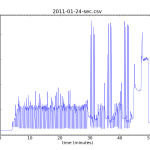 My wife calls it spying. I call it data. To-may-to, To-mah-to. It’s true that I know what she’s been up to (electrically) while I’m away. And it’s true that I can access this information anywhere in the world that has an internet connection. But domestic surveillance is not my aim (cameras and microphones would be far more informative in that regard). I just care about the energy angle.
My wife calls it spying. I call it data. To-may-to, To-mah-to. It’s true that I know what she’s been up to (electrically) while I’m away. And it’s true that I can access this information anywhere in the world that has an internet connection. But domestic surveillance is not my aim (cameras and microphones would be far more informative in that regard). I just care about the energy angle.
In this post, I will present example results from monitoring and recording my home electricity use, demonstrating the marvelous secret world it reveals. My interest lies in putting numbers on my own behaviors, and in characterizing the appliances in my house. Some of this rubs off on my wife, and some of it rubs her the wrong way. But as I explained in an earlier post, I kept a note she once wrote that said: “Okay, TED’s pretty cool.”
Who is TED? TED is The Energy Detective. That same earlier post told the story of TED’s tortured journey to our home—a tale of excitement, rejection, and ultimate acceptance.
This post is not meant to convey anything deep and meaningful about the energy challenges we face, except for the fact that those challenges provided a background motivation for me to explore and monitor energy data in my home (it should be obvious by now that I’m a data-holic). Rather, I will simply showcase a number of data captures from TED so you can see for yourself the interesting hidden behaviors of appliances, and develop some intuition about how much of a toll various devices take.
TED Basics
I should spend a little time telling you a bit about TED. At the heart of TED are two current-measuring clamps that each encircle power lines delivering two phases of AC electricity into the home. Tying into a two-phase circuit breaker via wire, it also knows the voltages of the two phases. Power is current times voltage, so TED simply accumulates the instantaneous current times voltage for each of the two phases. Out pops Watts, measured once per second.
The data are communicated through the electrical wires themselves—via the same wires that connect TED to the breaker. A communication unit inside the house plugs into any outlet to receive the information and relay it via ethernet to the (separately furnished) home networking equipment. Configuration of the router can allow password-protected access to TED from outside the home. An optional display receives wireless communication from the plugged-in communication device—albeit over a pathetically short range in my unit—and presents (among other options) the instantaneous power usage of the house in Watts.
I discussed before methods for using the utility meter on the side of the house to gauge power draw, but the methods are indirect and slow. Nothing beats a real-time reading in the house. Suddenly many curiosities may be satisfied. All the integrated devices (lighting, fans, air conditioning, electric ovens/stoves, hot tubs, etc.) that are not available for measurement via the Kill-A-Watt are now fair game. One useful exercise is to turn off breakers one by one during a quiet period in order to discover which circuits harbor phantoms—making it considerably easier to track them down in the house.
Moreover, TED data are stored automatically so that periodic retrieval can result in an uninterrupted record of electrical activity in the house. My favorite!
At one-second resolution, TED keeps the last ~65 minutes of data. I only export the one-second data after some particularly informative event, like a washing machine cycle. For one-minute resolution, TED stores a little over two days’ worth (this is what I routinely collect). I should note that the lower-resolution data is accumulated, rather than sampled. So usage that comes and goes within the course of a minute (or is activated/deactivated some time within the minute) is properly accounted/prorated. Hourly activity is recorded for the last hundred days or so, and daily and monthly totals are accumulated for longer than the 1.5 years over which I have owned my unit.
A web interface allows you to see what’s happening in real time; export data; configure the unit; or graph recent results. Example screenshots follow.
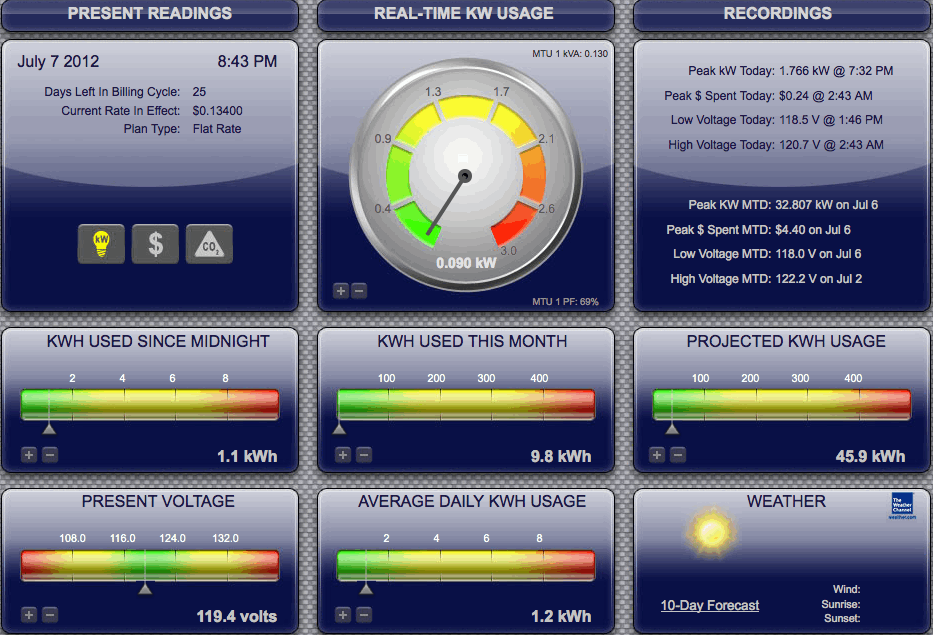
TED “dashboard” showing a variety of useful quick-look items. Note that the month-to-date peak power occasionally flips out (every few weeks) and reports a maximum power in excess of 32 kW, even though the recorded data does not reflect the anomaly. Average daily use and projected usage are based on the month to date, becoming more reliable as the month progresses and more days are added to the average.
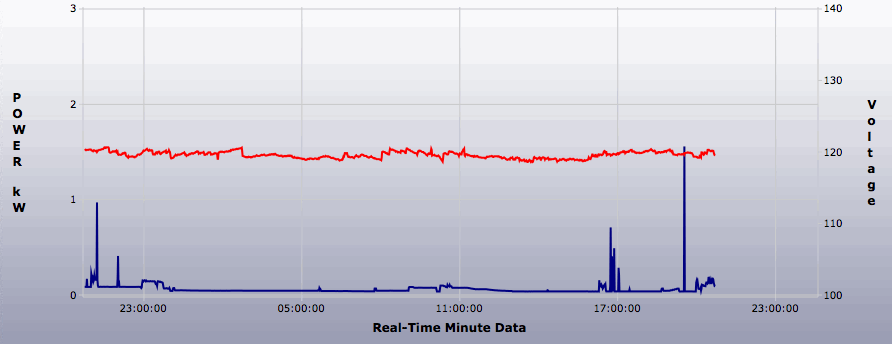
Activity over the last 24 hours, plotted. Voltage (uninteresting) is in red, and power (super-interesting) is in blue. Spikes are generally brief microwave usages (like the one at about 19:30). The activity around 17:00 is a circular saw, and skulking low around 19:00 (just before the microwave spike) is the bed-warmer test shown later in more detail.
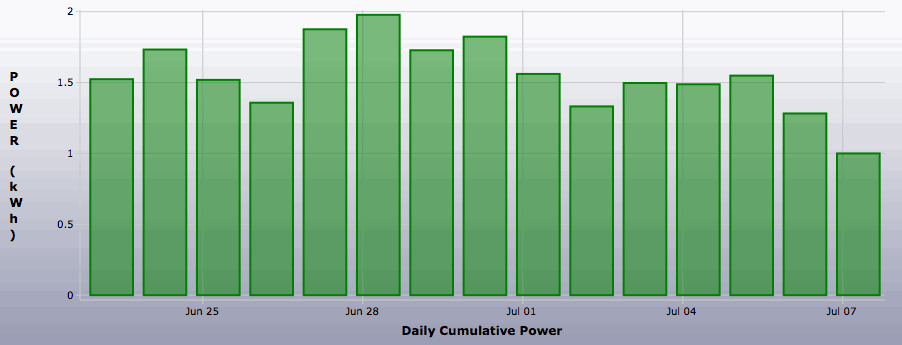
The last 15 days show our household using about 1.5 kWh per day of utility electricity. In the summer, we supplement this with typically about 4 kWh of off-grid solar input, most of which runs the attic fan during the hottest (and happily, sunniest) part of the day.
TED Funhouse
Okay, let’s take a look at examples of TED data captures. I will be using units of Watts and Watt-hours (Wh) to describe the results. For example, consuming electricity at a rate of 30 W for 10 minutes (one-sixth of an hour) accumulates 5 Wh, or 0.005 kWh in more familiar billing terms.
My TED data records are especially clean because many of the periodic/variable power draws in my house are serviced by the off-grid solar installation: refrigerator, computers, wireless and modem, entertainment console, etc.
Getting Warmed Up
As a rule of thumb, electrical devices designed to generate heat are power hogs—simply because significant thermal energy tends to cost a lot of Joules. Two exceptions in our house are a heating pad and a heated mattress pad: targeted, small-scale heat.

Heating pad (initial long pulse, becoming choppy thermostatic cycling), followed by a space heater run for a little over three minutes.
The plot above shows a heating pad turned on (at minute 7), staying on for about half-an-hour. In this time, the pad averaged 30 W (48 W when on). A heating pad on your lap, in your chair, or for your feet can eliminate the discomfort of sitting/working in a cold environment. Compare this to a space heater, seen in the latter part of the plot, running for just over three minutes. Despite running for only about one-tenth as long, the space heater accounts for 85% of the above-baseline power expenditure pictured here (84 Wh for the space heater vs. 15 Wh for the heating pad). We also see from this example the stability of the TED data: the baseline is flat, and the top of the space heater pulse is pretty flat also, showing very little fractional wavering (and what wavering there is may just as likely be attributed to actual variation in the heater).

Mattress pad heater (also barely visible around 19:00 in the 24 hour plot above). The heater was turned on one click at minute 16, then advanced another click every five minutes starting around minute 36. The pad automatically comes on full-scale for the first four minutes to pre-charge the thermal mass.
The mattress pad, like the heating pad, is about as modest as it gets when it comes to energy for heating. The pad we have has dual controls for each side of the bed, and this test represents only one side. The maximum scale is 30 W per side, with five equal steps of about 6 W. Now that the vertical scale only extends to about 70 W, we can see the TED measurement dithering at the 1 W level. In this case, I evaluated the baseline to be at 38.5 W, and the test consumed 10.7 Wh above baseline activity.
Garage Door Opener
This one will make appearances in some of the forthcoming examples, so let’s get it out of the way.
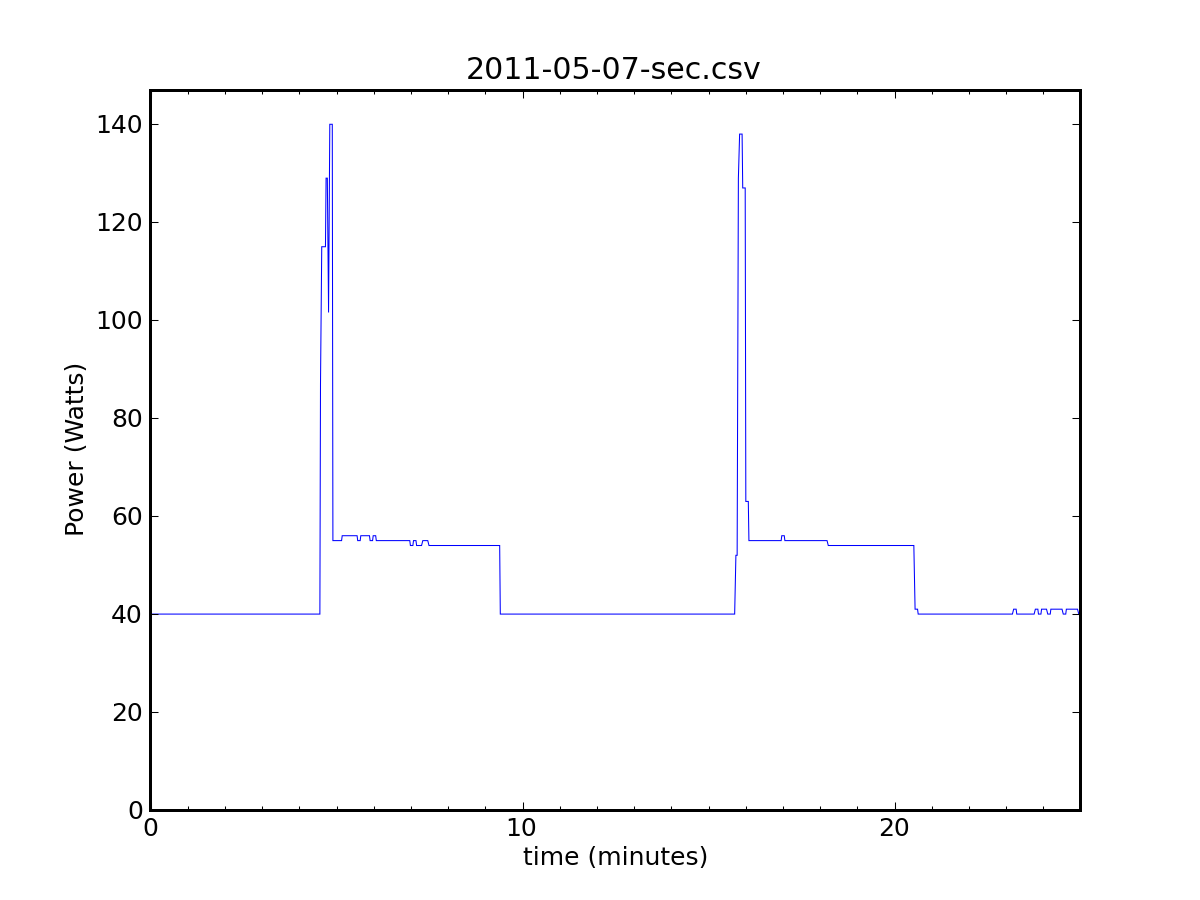
Opening and closing of the garage door, showing also the light (a compact fluorescent) staying on for about five minutes each time.
Raising the door required 1299 J, or 0.36 Wh, while the light (staying on for 290 seconds) consumed 4263 J (1.18 Wh), so that the light accounts for more than three-quarters of the total expenditure. Imagine what an incandescent would do! On the way down, the closing action required 951 J. All together, the opening and closing cost 2.95 Wh—even when the light was allowed to stay on. It is often easy to turn off the light manually, so why not make it a habit? One lesson from these small numbers: opening and closing the garage door is not a serious energy concern.
Domestic Service
Okay, let’s get busy. About a year ago, I made stairs to ascend the bank at the back of my yard. I cut the stringers out of four 2×12 10-foot boards, accommodating 9 stairs per stringer, making for 18 saw cuts per board. The 65-minute capture caught the tail end of the first set (board), followed by the next three complete sets.

Four sets of stair stringers (the last three fully captured) were cut with a circular saw, consisting of 18 high-power cuts each.
The time in between cutting periods accounts for measurement and layout work. Measure twice; cut once. The activity shown in the plot represents 370 Wh of work. If the saw peaks at 1800 W, that means the saw was on for an integrated 740 seconds out of the 65 minute span, or 19% of the time. Considering that the cutting phase totals 27 minutes, the actual saw-on time during the cutting phase was about 46%, which seems reasonable. As I cut the wood, I didn’t consider that my efficiency was being quantified by TED. But I happen not to mind spying on myself…

The dominant activity visible here is use of an electric lawn mower, but the sequence starts with laptop activity, the garage door and light, mowing three sections of yard, more garage door action, then back to the laptop.
This sequence shows a variety of actions, starting with laptop use (generally wiggly/variable). Normally our computers are powered by the off-grid solar setup, but sometimes a change of venue might put one of them on utility power. After opening the garage door, I failed to turn the light off manually. Three sections of yard were mowed, costing 57 Wh at a typical power of 600 W. After the mowing was done, the mower was wheeled into the garage, tripping the light—promptly turned off this time—then the garage door was closed and the light turned off immediately after. Naturally, I had to wake up the laptop to export the data from TED.
Furnace
Our gas furnace uses natural gas at a rate of about 75,000 Btu/hr (22 kW). But the air handling adds 600 W to this. Below are two furnace cycles in our house (rarely used: part of the test described in an earlier post).
First, the furnace’s internal blower turns on, followed by ignition of the gas about 30 seconds later. After another 30 seconds, the main house blower turns on (accompanied by an initial surge/spike). After about six minutes, the gas turns off, as does the internal blower. The main blower continues for another couple of minutes to deliver residual heat to the house. All told, each cycle is using about 80 Wh of energy (perhaps 240 Wh of fossil thermal energy at a power plant, if operating at 33% efficiency). Meanwhile, the energy expended in gas is about 2400 Wh. So approximately 10% of the expended energy is on the electrical side, or as little as 3% if the source is solar, wind, or hydroelectric—without the typical heat-engine loss.
Another useful measure that comes from such analysis is that, for my house, each Therm of energy (29.3 kWh) delivered by natural gas burned in the furnace is accompanied by 1 kWh of on-site electrical expenditure.
Appliances
This series corresponds to a time when the photovoltaic system’s battery was low (cloudy/rainy period), so all household power is reported by TED. It’s much noisier than usual. After the refrigerator cycle (characteristically higher power at first), the DVD player woke up wondering what time it was, and checked for cable service we no longer have to get the answer. It does this every hour, spending 13 minutes at 8 W, costing about 40 Wh per day. Normally, this system is on solar, and I have plenty of juice to cover it, so don’t really care. But maybe I should address it all the same.
But this data set is rather boring, yes? Let’s move on.
The clothes washer makes quite the rich TED subject. Firstly, our washer consumes 6 W to sit doing absolutely nothing if left plugged in. Criminal! 6 W may sound like a pittance, but when our utility electricity baseline is around 40 W (as seen in many of these TED plots), 6 W becomes substantial. Over the course of a year, it adds up to $6, or about one sizable burrito. So the first event we see in the plot is a little step corresponding to plugging in the machine. Then it’s a tumble, stop; tumble, stop sequence over and over as the machine practices the art of washing clothes. Later on, the soapy water is spun out, rinsed, and spun again, in cyclic fashion. At the end, things get serious as the drum spins up to 1000 rotations per minute or thereabouts to wring the clothes dry.
In total, the process consumed 132 Wh of energy.
Okay, want a bit of chaos? Here we have a clothes washing cycle starting two minutes in. The rice cooker is turned on at ten minutes, was on for 16 minutes, off for three (for some reason), then on for another 6. Also thrown in are short microwave cooking invocations at minutes 26, 35, 39, and 41.
Out of the total 420 Wh represented in this cacophony (above baseline), 183 Wh is attributable to the rice cooker, operating at 500 W. We’ll assume 132 Wh for the clothes washer—as was the case before. It looks like the microwave ran a total of about four minutes at 1740 W for 116 Wh. Adding these up, I get 430 Wh, which is close enough to 420 to satisfy me. Maybe the microwave ran twenty seconds less than my crude estimate, or the washing machine does not do exactly the same thing every time (could investigate…).
Finally, we have the dishwasher. Unfortunately, my tardy initiation of data export resulted in my missing the first three minutes of the dishwashing activity. But I know when it started based on the one-minute-sampled data (and set the left-hand extent of the axis to correspond to this time, for visual effect). The microwave oven makes two appearances, roughly compensating the unaccounted dishwasher energy at the beginning of the record. In total, this capture represents 660 Wh of energy expended. I don’t have much insight into the meanings of the various pulses, other than the general observation that the early big pulses must represent the wash phase, and the later period must involve rinsing and possibly heating—though we generally don’t use the high temperature wash option and turn off heated dry.
Cloudy Periods
As mentioned before, a number of our electrical devices are supported by the off-grid solar installation at our house. But during cloudy or rainy periods, my undersized battery bank will drain to the point that the smart inverter switches to utility input. During these times, the activity recorded by TED may be more typical of “normal” households, albeit still at modest scale.
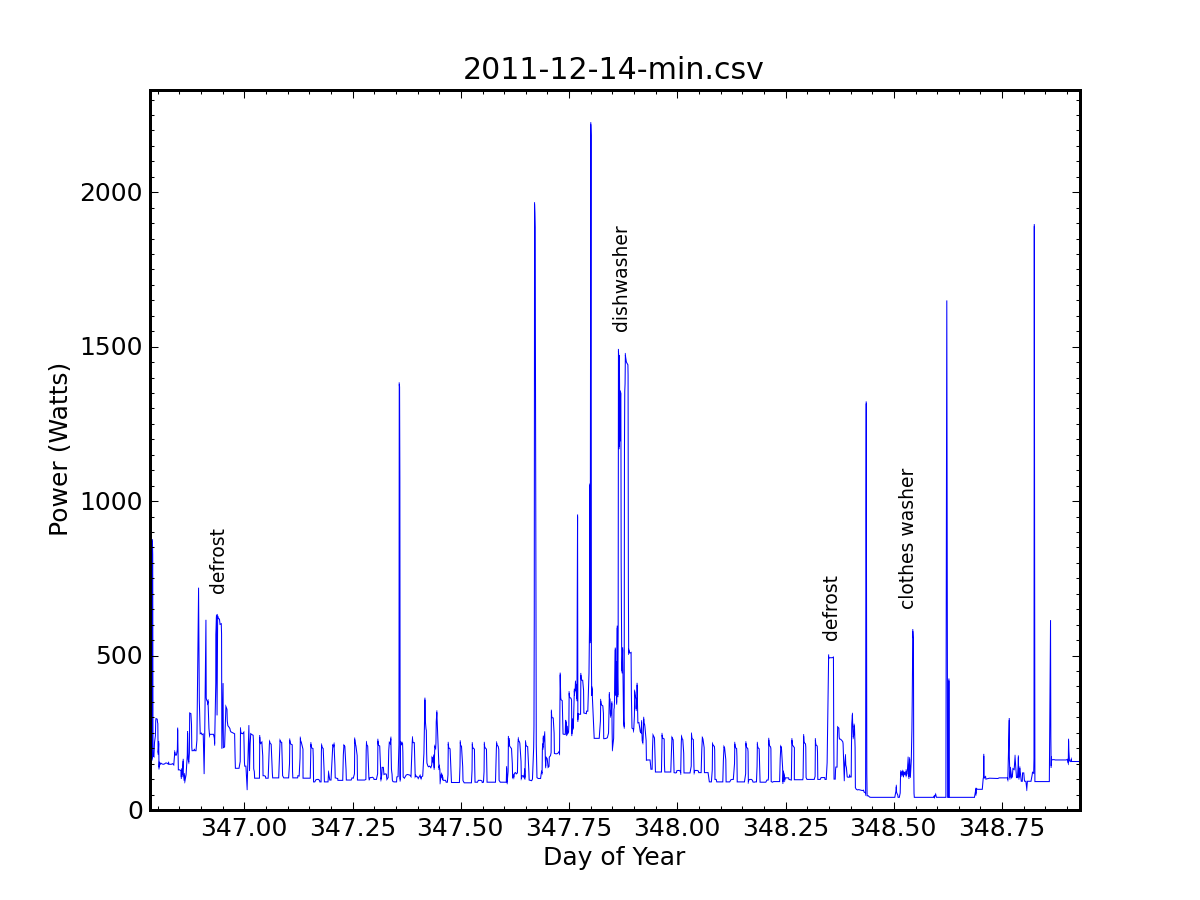
Two days of data when the solar input was mostly bypassed (solar re-engages at day 348.4). Local midnight corresponds to X.00 days, so that X.50 is noon and X.75 is 6 PM.
The refrigerator forms the visually dominant feature of this sequence, tirelessly cycling on and off. It can be easier to look at the bottom envelope of activity to sense the overall usage pattern. I note refrigerator defrost cycles at 346.94 and 348.36 days—corroborated by the longer cooling cycle after each heat pulse (see post on heat pumps). Most spikes are due to the microwave (or sometimes similar-power toaster oven). I recognize the lopsided signature of a clothes-washing cycle at 348.53, and the tell-tale two-horned visage of the dishwasher at 347.87. We hosted a dinner on the evening of day 347 (though the guests were likely unaware of the day number), which accounts for a higher-than-normal evening energy use (compare to evenings before and after), as well as the use of the dishwasher.
Summary Table
As a matter of convenience, I gather the results of the various measurements represented throughout this post. I crudely estimate the daily impact of each, based on our usage patterns—some of which are seasonal, and some of which don’t really apply to us (like the furnace, which we almost never use).
| Activity | Energy (Wh) | Daily Use | Notes/Conditions |
| Garage Door Open | 0.36 | 1.4 | 2 open/close per day |
| Garage Door with Light | 1.5 | 6.0 | 2 open/close per day |
| Mowing Small Lawn | 57 | 8 | weekly, summer months |
| Clothes Washer Cycle | 132 | 30 | at 1.5 loads per week |
| Rice Cooker | 180 | 50 | at twice per week |
| Heating Pad, 1 hour | 30 | 90 | at 3 hr/day in winter |
| Sawing 40 ft of Stair Stringers | 370 | — | not habitual |
| Microwave, 5 minutes | 150 | 150 | 5 min/day |
| Furnace Blower, 1 cycle | 80 | 160 | at 20 cycles/day (if used) |
| Mattress Pad, full-blast, both sides | 60 | 240 | 8 hr/day, half-blast, winter |
| Space Heater, 1 hour | 1400 | 280 | at 12 minutes/day, winter |
| Refrigerator, 1 cycle | 20 | 1000 | efficient (40 W) fridge |
Postlude
As I disclosed at the beginning, I was not aiming for any momentous conclusion in this post. And maybe a post with plot after plot of energy activities in my home is of little interest to people outside my household—and maybe only to half of those within, come to think of it. But hey, I learned something from each one of them, and hope the plots are worthwhile to others as well.
There are many appliances I don’t have, so cannot show. And our usage is modest enough that we seldom have lots of things happening at once. So it’s not as hard to disentangle events in these plots as it might be for more active households.
I would still like to test our almost-never-used air conditioning unit sometime and see how the thermal performance of our house in cooling mode compares to heating mode, and what kind of efficiency leverage we’re getting from the heat pump. I know many in the U.S. will cringe to hear it, and I’m not saying this to be mean, but we have yet to see temperatures this year in San Diego that call for cooling. Our July 4 was a cold and windy day. No wonder the fireworks all went off in a 15 second frenzy: they couldn’t stand the cold and wanted to hurry up the show!
Okay—Irresistible Aside
If you haven’t heard about it, a technical glitch caused the coordinated fireworks displays across San Diego to fire all at once during this year’s July 4th celebration. I was at a party where we managed to get atop a local hill in time to see the Sea World fireworks a bit later, but missed the municipal debacle. So I had to watch a youtube video (or see here for a view of three displays in one frame). All I can say is that had I been close at hand to one of the accelerated displays, I would have been laughing so hard I might have had trouble breathing for the next several minutes. Many spectators were deeply disappointed and complained bitterly. But this would have been the best fireworks display of my life, and one I would never forget—unlike all the rest that become boring by the end and then fade into obscurity. Awesome!
Views: 2544

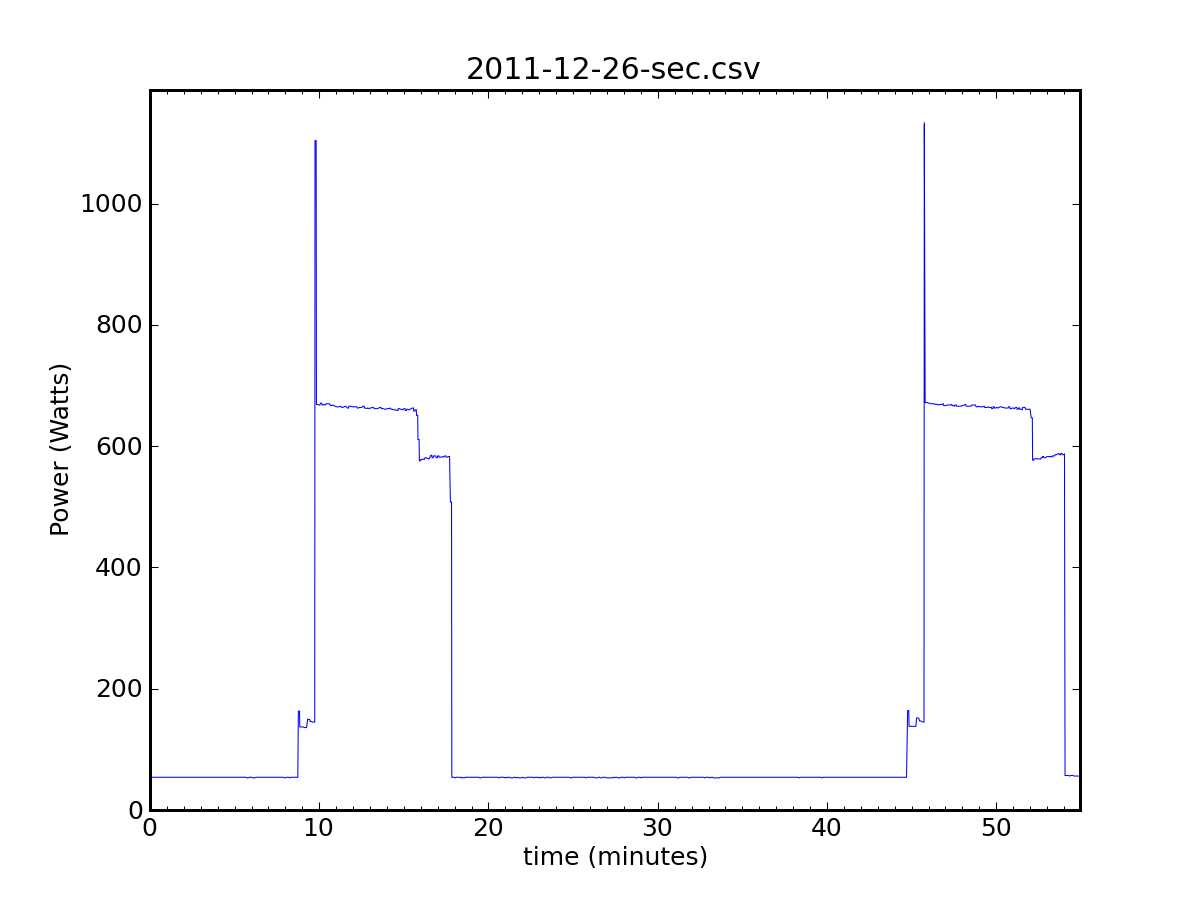
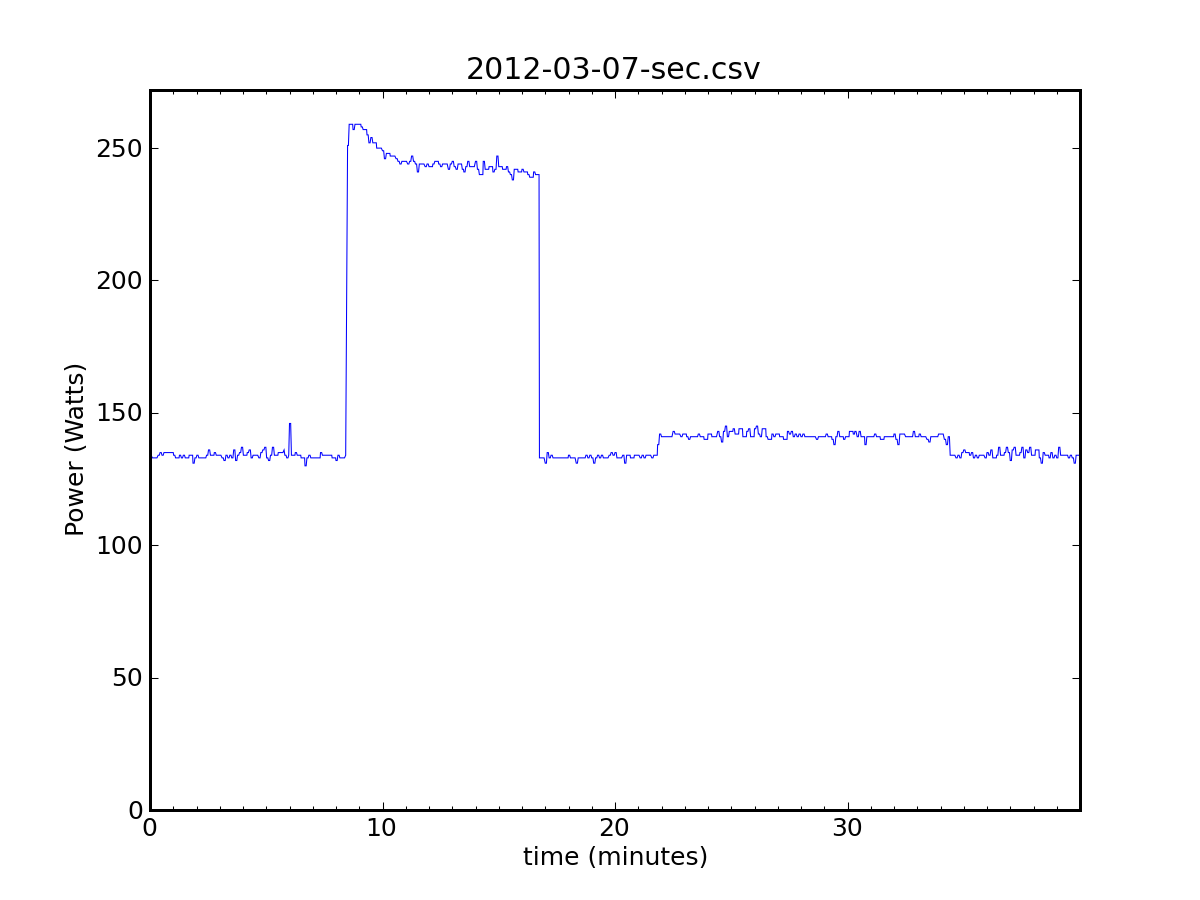
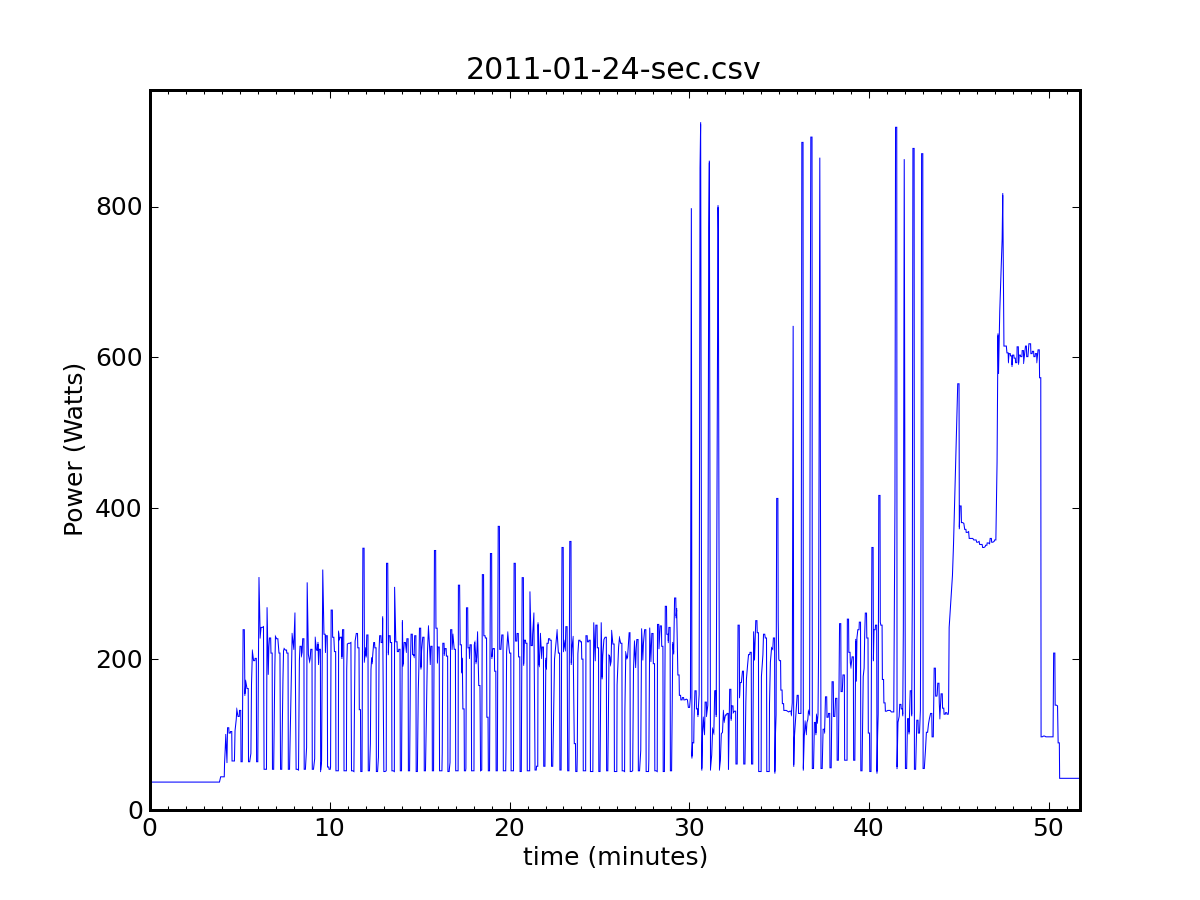
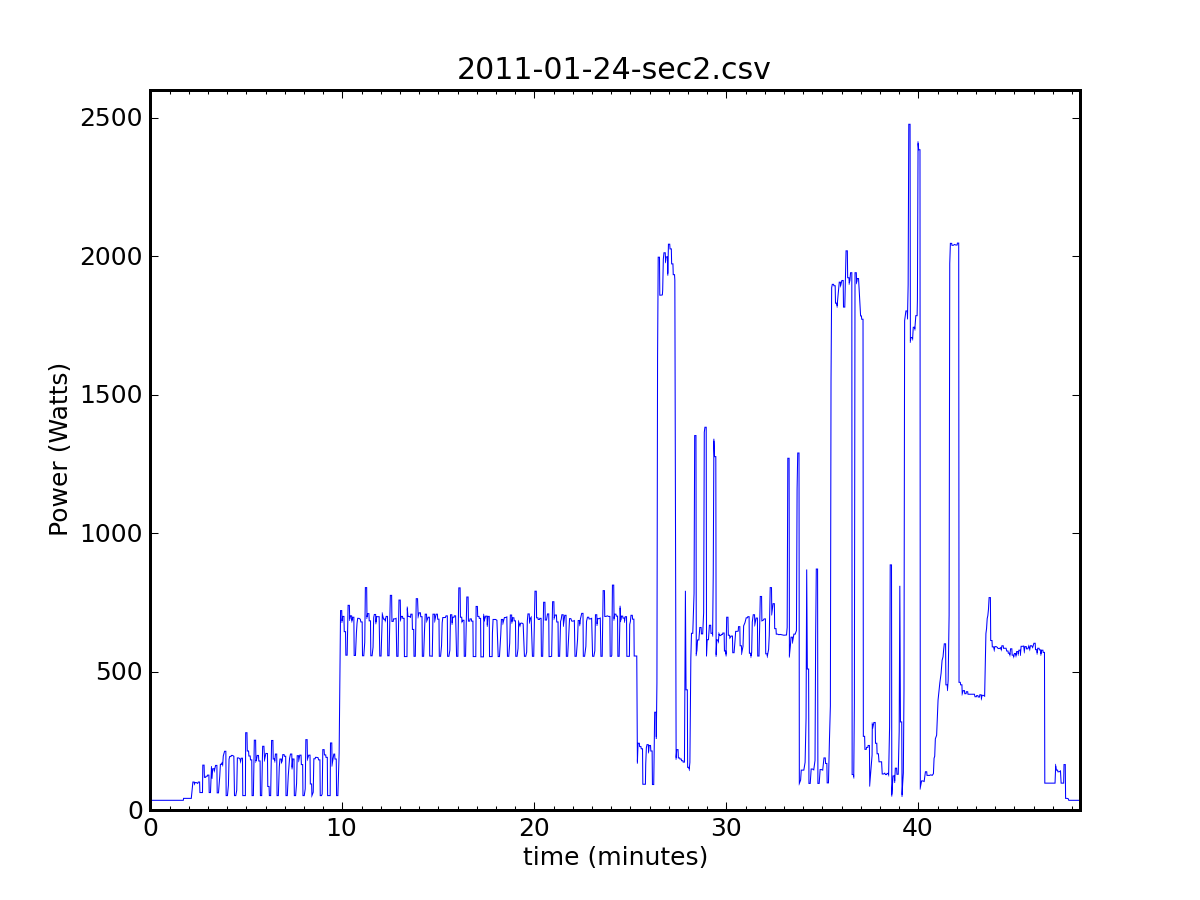
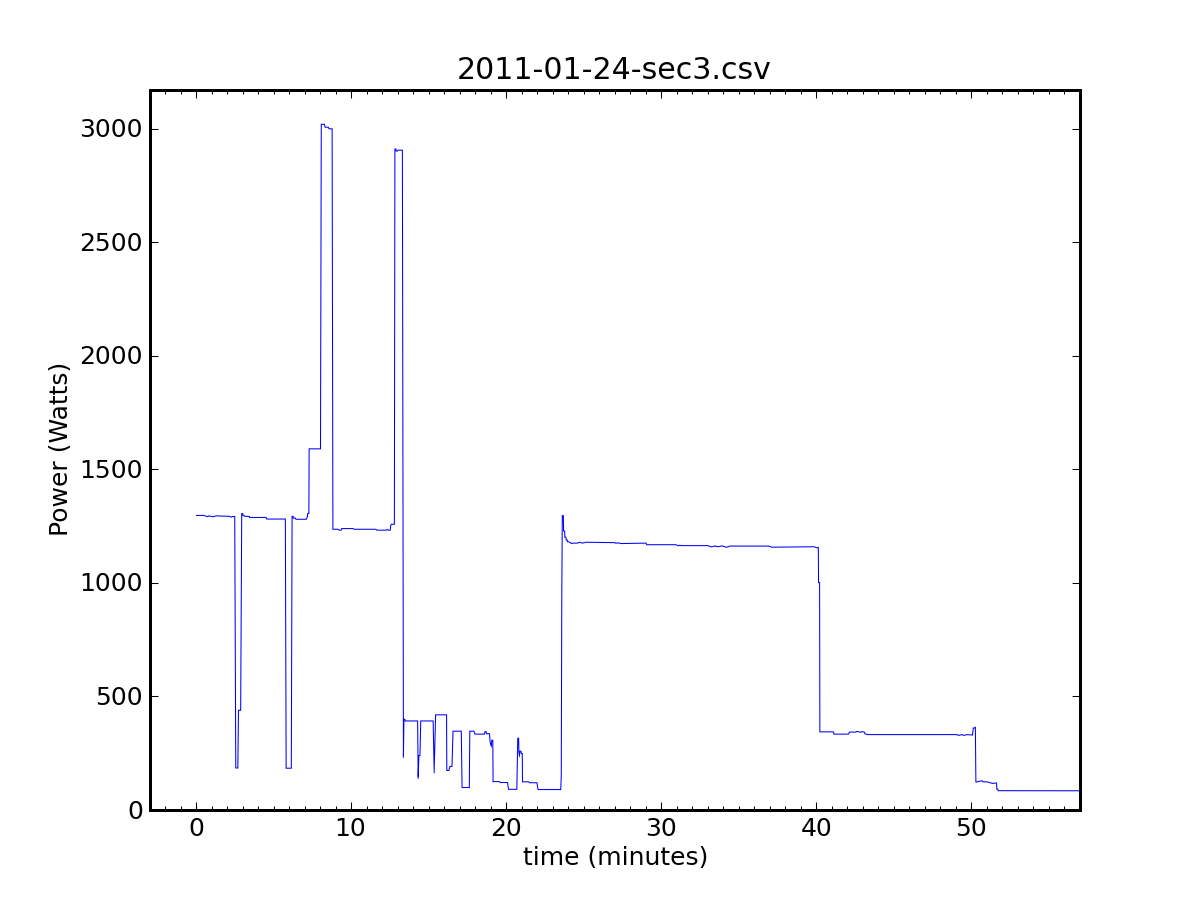
Your plots look generally scientific, but not so much that someone couldn’t make something similar useful for lay people.
I mention this because an entrepreneur could take data and a presentation like this and make it into a consumer product. We know measurement alone helps change consumption — of energy as much as food.
Most people have zero way of determining how much energy something uses so they don’t care. How can we blame them if they can’t access the data? Even if they want to cut back, how could they when power usage is only available integrated monthly?
Make the data easy to see and do something about and they’ll care and know what to do, even if only to save cash.
The money for the entrepreneur comes from the saved energy cost. This post would be a proof of concept.
I’m posting the idea in the hopes someone runs with it. I’d happily be one of their first customers.
A couple of months ago I interviewed a statisticians working for a power company in the UK. He was working on using the data on their side to guess what kind of appliances are on in your house at any time (they had consumption profiles for most electrical goods similar to the ones you showed above). Their main target was to provide a much more detailed bill for users (e.g you used x kWh on the fridges, etc…). It was aimed at businesses, but they were thinking to roll in out to consumers… I wonder if people realize how much information utility companies could collect… It only works with the newer digital meters though.
I thought you’d feel better there are more people doing this kind of stuff…
Tom, is there any chance you could provide some details on your batteries and inverter?
With my oversized PV array and solar water heater, I easily generate enough of a surplus to cover your electricity usage as well as my own. (I intentionally got an oversized system with the plan of “Real Soon Now” getting an electric vehicle.)
Of course, because it’s a grid-tied system, I only have power when the utility is supplying power. The utility is amazingly reliable here; we generally go years between outages, and then only in major storms, and then even an hour is a really long outage. Still, it’d be nice to have some sort of backup, especially considering that I’m already generating far more than enough right here on the premises.
I’ve understood it can get expensive really quickly for the combination of batteries and an inverter that properly isolates the PV and the grid (I have no desire to even hypothetically place a lineman’s life at risk), so this isn’t something I’ve really looked into. Indeed, I’ve even thought about a standard gasoline-powered generator for backup, and dismissed that.
But your aside there made me think that perhaps it might not be such a big deal, after all…
Thanks,
b&
I am planning a dedicated post about my solar installation in the not-too-distant future. So I’ll answer your question, but ask other readers to defer follow-up discussion of the off-grid PV system for a few weeks.
I have 8 130 W panels feeding four Trojan T-1275 golf-cart batteries, and an Outback VFX3524 inverter. This inverter can take AC power in, but cannot ship power back out to the grid. So it’s lineman-safe. It means spilling power once the batteries are full. But there are worse crimes in nature. That energy would just be spilled on my roof otherwise, so at least I capture what I can (and what I need, more importantly).
Tom, I am very much looking forward to this post on your system. Ideally there would be a way to charge the batteries first, then feed the excess into the grid (and be compensated for it) but then not feed power into the grid if there is a problem in the grid. Maybe this is a feature of a future “smart grid” tah would be really smart?
An alternative would be to charge you EV first, then feed the grid after the car’s battery pack was full. And in the event of a power outage, ideally, your house could disconnect from the grid and use the EV’s battery pack at night and the panels during the day, along with charging the pack. Whew — a lot to ask, but as long as we are re-imagining things, why not?
Neil
I’ve seen news stories here in Boston where people who have an hybrid electric car use that as battery backup for their house when a power outage occurs (using an inverter you can use your prius as a gasoline power generator/battery system to power your fridge and lights…)
See my equivalent measures on http://construction.huillard.net/conception/avant
That was in our older house. I’ll measure in our new passive house ASAP (by the end of 2012 hopefully).
Tom- it looks like the fridge uses almost exactly half of the daily energy of everything you listed. Have you considered switching to a chest fridge (i.e. chest freezer with conversion)? From what I have read, those use about 100 to 200 wh per day. I say this with some personal interest, as I am considering doing that myself in the near future, and if you did that (and wrote a post about it) first, I could learn from your mistakes 🙂
Cool to see someone else’s TED data with much more modest usage. We use around 28 kWh/day, which is roughly 1/3 water heating (4500 watts when on), 1/3 refrigeration (two fridges and a freezer for long-term storage, and not the most efficient models either), and 1/3 everything else. When no one is home refrigeration becomes 95% of the demand, at 9.5 kWh/day or so.
Wow. I’m picturing a walk-in freezer? We had an older side-by-side refrigerator that averaged 75 W (1.8 kWh/day), and might push up to 100 W average (2.4 kWh/day) when it was unpleasantly warm inside. I can’t imagine 9.5 kWh/day from refrigeration without either special circumstances, or a case of mistaken identity (e.g., large baseline “underneath” fridge cycles).
Throw a Kill-A-Watt on the fridge and see if you get the same answer for daily consumption…
I was a bit off on my numbers. Now, with the data in front of me:
Lowest recorded daily usage: 8.94 kWh (with no one home)
Refrigeration daily usage: 7.25 kWh (81% of always-on total)
Kill-a-Watt data for individual appliances:
Kitchen refrigerator with side freezer: 170W on, 3W off, 47% duty cycle, average usage 81.5W, 1.96 kWh/day
Garage refrigerator with top freezer: 180W on, 40W off (!), 40% duty cycle, average usage 95.5W, 2.29 kWh/day
Large old chest freezer: 260W on, 0W off, 48% duty cycle, average usage 125W, 3.00 kWh/day
This is a rental property. Two of the units came with the property, the freezer was acquired for free. Total cost for all three comes to $265 per year, or $66.25 per year for each household member. We are all students, so none of us can really afford new appliances, nor would we want to since we may well be moving across the country in a year or two. So for now, unfortunately, we live with inefficiency. It does make me feel a bit hypocritical when preaching conservation though…
This one is off-topic, but with a very minimal knowledge of science one can see that it has some pretty deep insights in addition to much useful and practical information.
The Survival Podcast, hosted by Jack Spirko:
Episode-939- Steven Harris on Dealing with a Large Scale Blackout – Part 1 July 11, 2012 at 7:32 am
Well, since it’s about utility electricity, and this is a slow comment forum, we’ll let it through…
There is one DtM post from last September on a similar topic of the San Diego surprise blackout.
Tom, you know they make these things called hand saws, have for hundreds of years. You can also get a mechanical push mower, maybe, I saw one on TV once a long time ago. LOL
It’s funny you should mention this. I often prefer a hand saw, and frequently use one in situations that would baffle the average Joe. But even I balked at cutting 40 feet of stringers by hand. And I used a hand mower for years, but went electric when I moved to S.D. for some reason…
Using an eMonitor data logger (18channels) in my load center – that is, I’m logging each house circuit, PV production & ST pump use. Much too expensive a gadget/ web portal for $1000, but I won it in a green contest!
Lame screen shot (no graphs):
https://emonitor.us/user/67psy5llyuo/779
Another great article, Tom; thank you.
All of our major appliances, including our two ductless heat pumps and electric water heater are plugged into power monitors (all operate at 115-volts) and this information is recorded daily in a spreadsheet. During the heating season, I also log hourly temperatures so that I can see how temperature influences heating demand (these two ductless heat pumps supply 100 per cent of our space heating needs).
A breakout by month can be found at:
Oct – http://i362.photobucket.com/albums/oo69/HereinHalifax/2011-10.jpg
Nov – http://i362.photobucket.com/albums/oo69/HereinHalifax/2011-11.jpg
Dec – http://i362.photobucket.com/albums/oo69/HereinHalifax/2011-12.jpg
Jan – http://i362.photobucket.com/albums/oo69/HereinHalifax/2012-01.jpg
Feb – http://i362.photobucket.com/albums/oo69/HereinHalifax/2012-02.jpg
Mar – http://i362.photobucket.com/albums/oo69/HereinHalifax/2012-03.jpg
Apr – http://i362.photobucket.com/albums/oo69/HereinHalifax/2012-04.jpg
May – http://i362.photobucket.com/albums/oo69/HereinHalifax/2012-05.jpg
The blue line is temperature, with the left axis being °C. The right axis is kWh and each column represents their combined usage for that particular day. Real-time logging by circuit, with a product such as the eMonitor that Jim mentioned above, would be a huge leap forward, but for now a daily synopsis recorded by hand will have to suffice.
Cheers,
Paul